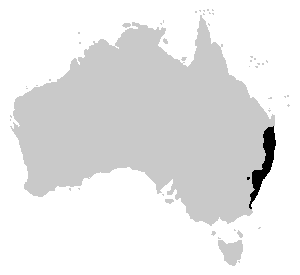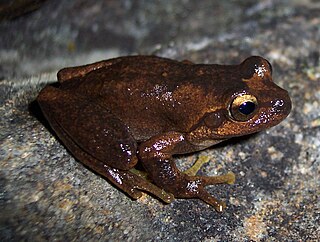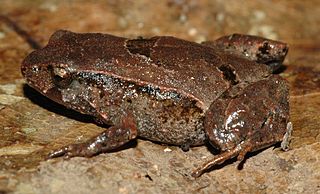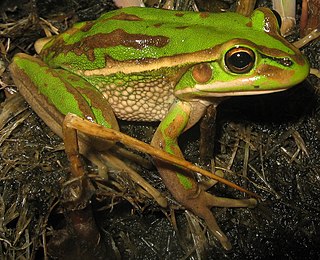
Litoria is a genus of hylid tree frogs, sometimes collectively referred to as Australasian treefrogs.

The Australian green tree frog, also known as simply green tree frog in Australia, White's tree frog, or dumpy tree frog, is a species of tree frog native to Australia and New Guinea, with introduced populations in the United States and New Zealand, though the latter is believed to have died out. It is morphologically similar to some other members of its genus, particularly the magnificent tree frog (R. splendida) and the white-lipped tree frog (R. infrafrenata).

Ranoidea chloris, commonly known as the red-eyed tree frog or orange-eyed tree frog, is a species of tree frog native to eastern Australia; ranging from south of Sydney to Proserpine in mid-northern Queensland.

The magnificent tree frog, also known as the splendid tree frog, is a species of tree frog first described in 1977. It has a limited range, only occurring on the north-western coast of Australia in the Northern Territory and Western Australia. It has a similar appearance to, and can be confused with, the closely related White's tree frog.

The robust bleating tree frog, also known as Keferstein's tree frog, is a species of tree frog in the subfamily Pelodryadinae. This frog is endemic to coastal eastern Australia, where it ranges from northeastern New South Wales to the NSW/Queensland border. It has also been introduced to Lord Howe Island.

The Jervis Bay tree frog, also known as the curry frog in reference to its odour, is a species of Australian frog associated with wallum swampland along the east coast of New South Wales; ranging from the Queensland border to eastern Victoria.

The dainty green tree frog, also known as the graceful tree frog, is a species of tree frog in the subfamily Pelodryadinae. It is native to eastern Queensland, and north-eastern New South Wales, Australia and ranges from northern Cape York in Queensland to Gosford in New South Wales, with a small and most likely introduced population in Hornsby Heights in Sydney. It is one of two faunal emblems of the City of Brisbane.

Littlejohn's tree frog, also called a heath frog or orange-bellied tree frog, is a species of tree frog native to eastern Australia from Wyong, New South Wales, to Buchan, Victoria.

The desert tree frog, or little red tree frog, is a species of tree frog native to Australia, southern New Guinea, and Timor. It is one of Australia's most widely distributed frogs, inhabiting northern Australia, including desert regions and much of temperate eastern Australia. It is one of the few Australian tree frogs to inhabit arid, tropical, and temperate climates.

Assa is a genus of frog in the family Myobatrachidae. These frogs are endemic to a few parts of eastern Australia.

Ranoidea is a genus of frogs in the subfamily Pelodryadinae. They are found in Australia, New Guinea, and two nearby groups of islands: the Maluku Islands, and the Louisiade Archipelago. The circumscription of this taxon is still controversial.
Watson's tree frog, also known as the large brown tree frog or southern heath frog, is a species of tree frog endemic to south-eastern Australia.
The slender bleating tree frog, is a frog in the family Hylidae. It is endemic to Australia, where it is found in Queensland and the Bunya Mountains. This is the "bleating tree frog" that occurs around Brisbane.
Litoria gracilis, also known as the slender spotted tree frog, is a species of frog in the subfamily Pelodryadinae. It was described in 2023 by Australian herpetologist Stephen Richards and his colleagues Stephen Donnellan and Paul Oliver.
Litoria naispela, also known as the Crater Mountain treehole frog, is a species of frog in the subfamily Pelodryadinae. It was described in 2023 by Australian herpetologist Stephen Richards and his colleagues Stephen Donnellan and Paul Oliver. The specific epithet naispela is a Tok Pisin term meaning ‘beautiful’ or ‘attractive’.
Assa wollumbin, the Wollumbin pouched frog or Mount Wollumbin hip-pocket frog, is a species of small, terrestrial frog endemic to New South Wales, Australia. It is restricted to the slopes of Mount Warning (Wollumbin), where it inhabits rainforest habitat.
The Mount Ballow mountain frog is a species of frog in the family Limnodynastidae. It is endemic to eastern Australia, straddling the border of Queensland and New South Wales. It is known only from the central and western McPherson Ranges, in the Gondwana Rainforests World Heritage Site.
The bleating tree frog of Australia has been split into three distinct species:
The southern stuttering frog is a large species of frog endemic to south-eastern Australia. It is found in mid-eastern New South Wales and at least formerly Victoria, where it ranges from Carrai National Park south to East Gippsland. It inhabits temperate and subtropical rainforest, wet sclerophyll forest, and moist gullies in dry forests.










